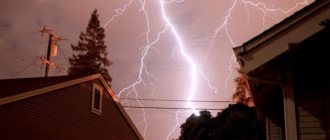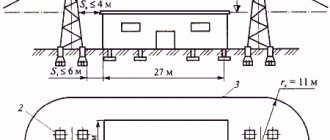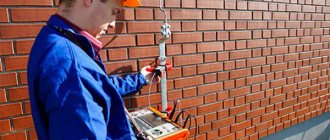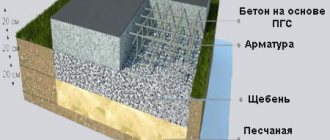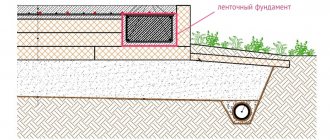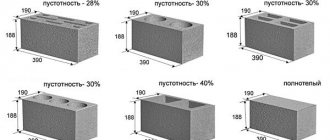Determination of fire resistance limit
The fire resistance limit of any structure is determined as follows. It is customary to take as a basis the time that passes from the beginning of the fire itself to the moment of occurrence of any limiting state of fire resistance of the selected element. In particular:
By density: the appearance of through holes or cracks through which combustion products and fire can easily penetrate.
In terms of thermal insulation ability: the indicator is an increase in temperature by more than 160 degrees (on average), or by 190 (at any selected point on the surface of the structure) compared to the temperature before the test. An increase in temperature of more than 220 degrees is also taken into account, regardless of the initial recorded temperature.
For the loss of bearing capacity of structures and components - depending on the type and structure of the structure, deformation or collapse is taken into account.
Studies have shown that reinforced concrete structures have the highest fire resistance. The smallest is typical for metal structures.
Considering that any building consists of various constituent elements, this indicator can vary significantly. However, in general, it is customary to distinguish several degrees of fire resistance, which are usually identified in Roman numerals from I to V.
Gelendzhik: from Kabardinka to Teshebs
A whole conversation ensued with one of the visitors to my site (Tatyana F.) about determining the degree of fire resistance of a house (you can see the details in the comments HERE). But I think that this topic is of interest to many, so I decided to write a whole article about it.
The degree of fire resistance of a house: how to determine
Do you know the saying “We wanted the best, but it turned out as always...”? So, the same thing is happening with some fire safety standards at the moment. They are written in such a way that sometimes even a fire inspector cannot figure it out.
Take, for example, the fire resistance rating of a house. How to determine it?
Previously, there was a very good SNiP 2.01.02-85 * “Fire Safety Standards”, which had an excellent appendix No. 2 on the degrees of fire resistance of houses (a hint for inspectors, who in those days did not all have higher education in their field):
Everything is clear, as they say, explained “on the fingers”.
The next question that arises is whether this gradation corresponds to the degree of fire resistance. Let's find out. So, here is table 1 from the same SNiP (to enlarge it, click on it with the mouse - it will open in the same window):
Now let’s look at SNiP 21-01-97* or technical regulations (Federal Law No. 123):
As you can see, the number of fire resistance levels of buildings has decreased (the third and fourth “absorbed” the “sublevels”). Therefore, we will compare only the main ones. So:
I СО for load-bearing walls - now R 120 (and R is the fire resistance limit of a building structure, in minutes), and previously it was 2.5 hours (that is, 150 minutes);
I CO for floors - now REI is 60 minutes, but before it was 1 hour (that is, the same 60 minutes).
It turns out that for buildings I CO the requirements have even decreased.
We check the third degree of fire resistance, which includes houses with load-bearing brick walls and wooden floors:
- for walls - now R 45, it was - 2 hours,
- overlaps - now REI is 45 minutes, it was 0.75 hours (this is also 45 minutes).
Basically, the same thing.
This means that houses with load-bearing brick walls and wooden floors can now also be classified as the third building standard. But! Attention! In order for a wooden floor to meet the requirements for fire resistance class 3, it must have a fire resistance rating of at least 45 minutes. And this is only possible if:
- wooden flooring with a roll or with hemming and plaster over shingles or mesh with a plaster thickness of more than 2 centimeters (the fire resistance limit will be 0.75 hours),
- overlap on wooden beams when rolled up from fireproof materials and protected with a layer of gypsum or plaster at least 2 centimeters thick (fire resistance limit 1 hour).
There are other options for wooden floors (I took information from the Manual on determining the fire resistance limits of structures, the limits of fire spread in structures and flammability groups of materials, Moscow, 1985; the manuals were periodically updated, they are - or were until 2007 - every “regulator" ", that is, each fire inspector who was involved in inspections of newly built and reconstructed facilities).
That is, in principle, if you are concerned about how to determine the degree of fire resistance of a house yourself, you can safely use the “hint” from the old SNiP. Just keep in mind that the degree of fire resistance of a building is established according to the very minimum fire resistance limit of the structure in your building.
Reducing the fire resistance of a house
Let's return to the comment left on the site:
At the beginning, while Tatyana and I were corresponding and she only said that her house with brick walls and wooden floors was recognized as a house of the fifth degree of fire resistance, I thought that the inspector was mistaken. However, after clarification (see the description of the house in the above comment), it turned out that the inspector, in principle, was right. What reduced the fire resistance level of this house from third to fifth?
So, firstly, the cause was a wooden attic. Its degree of fire resistance, according to the inspectors who visited Tatyana, is fifth, since the load-bearing structures made of wood are not protected on both sides by non-combustible materials.
Secondly, although Tatyana’s ceiling is made of wood, it also does not have protection from non-combustible materials (“the house is lined with clapboard inside”). That is, such a ceiling is also not suitable for the third degree of fire resistance, and it is already classified by inspectors as the fifth degree of fire resistance (actually, roughly speaking, the fifth degree of fire resistance is a wooden shed that burns quickly and hot).
The result: due to the attic and unprotected wooden floor, Tatyana’s brick house “moved” from the third to the fifth degree of fire resistance. And then he “pulled” the fire distances.
However, if you look at MDS 21-1.98, then you and I will see something interesting (last line):
Let's look: “Load-bearing and enclosing structures made of wood or other materials of group G4” - this is the fourth degree of fire resistance and structural fire hazard class C3. What is group G4? This is a group that includes highly flammable materials, which also includes wood not treated with fire retardants.
What happens in the end? Judging by MDS 21-1.98, then Tatyana’s house should be classified as the fourth degree of fire resistance of buildings (the fifth degree of fire resistance in this case simply does not exist, since none of the indicators are standardized for it at all). But in this case this is not so important, since according to the table of fire distances, it will be the same for both the fourth and fifth degrees of fire resistance for a given class of structural fire hazard.
By the way, MDS 21-1.98 is just a manual for inspectors (“hint”), and not a mandatory regulatory document. So in the situation with Tatyana, everything depended on the inspectors competently justifying their point of view with references to the results of practical tests of similar structures.
And if the question of determining the degree of fire resistance of a building is more stringent, then inspectors themselves usually recommend ordering appropriate tests to determine the actual fire resistance limit of structures, which are carried out by special laboratories. This pleasure is not cheap and is usually used only in new buildings during legal proceedings.
Did you like the article? Tell your friends about it:
.
There are no similar articles.
Degrees of fire resistance and their characteristics
The allocation of five basic degrees of fire resistance of buildings and structures is carried out in accordance with SNiP 21.01-97. As a rule, the basis for deriving this indicator is the degree of fire resistance of the main structural elements that play a functional role.
Let us give approximate characteristics of knowledge depending on the indicator of their fire resistance
- I degree. Buildings with enclosing and load-bearing structures using slab and sheet non-combustible materials, reinforced concrete, and concrete. And also built on the basis of both natural and artificial materials.
- II degree. The buildings have characteristics similar to those described above. Additionally, buildings may also have unprotected steel structures covering them.
- III degree. Buildings whose load-bearing or enclosing structures are constructed using both natural and artificial materials (in particular stone). Floors can be erected from wood, provided they are protected with low-flammability materials (plaster, slabs, etc.). Elements of the attic covering of the building must also undergo fire retardant treatment using special materials. Requirements related to fire distribution, as well as directly to fire resistance indicators, do not apply to coating elements.
- IIIa degree. Buildings most often have a frame structural design. These elements (unprotected structures) are most often made of steel. For the manufacture of enclosing structures, profiled sheets of steel or other material (non-flammable or with insulation made of low-flammable material) are used.
- IIIb degree. This category includes mainly one-story buildings with a frame structural design. Frame elements in most cases are made of wood (it is acceptable to use either solid or glued material). The required fire spread limit is achieved by treating the wood with special materials. Wood, as well as any materials based on it, can be used for enclosing structures; The enclosing structures themselves can be assembled from panels or element by element. In order for the required fire distribution limit to be achieved, and for the wood to be maximally protected from fire and temperature effects, it should also be treated with materials that give it the required properties.
- IV degree. Knowledge is distinguished by load-bearing as well as enclosing structures built from flammable or low-combustible materials. To protect against fire, slab and sheet materials, as well as plaster, can be used. Coating elements must not meet certain requirements in terms of fire resistance, as well as the limit of fire spread. However, if necessary, elements of the attic covering can be treated from exposure to both high temperatures and open fire.
- IVa degree. One-story buildings with a frame structural design. The elements of the frame itself are most often made of steel structures that do not have special protection. Building envelopes are built using non-combustible materials or materials with special flammable insulation (for example, profiled iron).
- V degree. This category includes those buildings whose load-bearing and enclosing structures can have an arbitrary indicator of fire resistance and fire spread limit. There are no other requirements for them.
Fire resistance of buildings and structures
Having dealt with building materials, we move on to the fire resistance of buildings and structures. It must be noted that not all buildings have identical materials throughout the entire structure . That is, the same building materials are not always used in all construction projects in each part (floors, rooms, etc.). Therefore, the classification by fire resistance is considered conditional. But in any case, all construction projects are divided into three classes: fireproof, difficult to burn, combustible.
The degree of fire resistance of a building - how to determine. The calculation is based on the time from the start of the fire to the moment of destruction or the appearance of defects. Therefore, it is important to understand what defects in load-bearing structures can be taken into account in order to accurately say that the structure is at the limit of destruction.
- Through holes and cracks appear through which fire flames and smoke penetrate.
- The heating temperature of structures increases from +160C to +190C. This refers to the non-burning side. For example, if a room is on fire, and the wall on the other side heats up to the above levels, then this is a critical moment.
- The supporting structure becomes deformed, leading to collapse. This mainly concerns metal components and structures. By the way, unprotected steel profiles belong to the KM4 category. At a temperature of +1000C they simply begin to melt. “KM0” includes reinforced concrete products.
As for the speed and time of combustion, as mentioned above, everything depends on the materials from which they are built. For example, a concrete structure 25 cm thick burns in 240 minutes , brickwork in 300 minutes, a metal structure in 20, a wooden door (entrance, treated with fire retardants) in 60, a wooden structure covered with plasterboard 2 cm thick burns in 75 minutes.
Classification according to the degree of fire resistance of buildings, structures and fire compartments
All construction projects are divided into five degrees. And this indicator must be indicated in the building’s passport.
Attention! The degree of fire resistance of a building can only be determined by authorized services. They are the ones who give the assessment and determine the class that is entered in the passport.
So, the degree of fire resistance of buildings and structures is a table of five fire resistance classes (IV), which determine the fire hazard of a structure.
| Class | Design Features |
| I | Objects built entirely from non-combustible materials: stone, concrete or reinforced concrete. |
| II | Structures in which metal components are partially used as load-bearing structures. Brick houses also belong to this class. |
| III | Buildings belonging to the first category are only allowed to use wooden floors in their structures, covered with plaster mortars or gypsum boards. To cover wooden floors, you can use sheet materials belonging to the group of “hard-to-burn” materials. As for roofs, wood can be used here too, only with treatment with fire-retardant compounds. |
| IIIa | Frame houses made of a metal base (steel profiles), which have a low degree of fire resistance. They are sheathed with non-flammable materials. here you can use insulation made of fire-resistant material. |
| IIIb | Wooden houses or buildings made of composite materials, the basis of which is wood. Buildings must be treated with fire retardants. The main requirement for them is to build away from possible sources of fire. |
| IV | Buildings constructed of wood, the structures of which are covered on all sides with plaster mortars, gypsum boards or other insulating materials capable of containing the effects of fire for some time . The roof must be fire protected. |
| IVa | Building structures assembled from steel profiles untreated with protective compounds. The only thing is the floors, which are also assembled from steel structures, but using fireproof heat-insulating materials. |
| V | Buildings and structures that are not subject to any requirements regarding fire resistance, ignition rate, etc. |
Types of fire resistance
Having understood the classes of fire resistance of buildings, it is necessary to identify the types of this characteristic. There are only two positions here: actual fire resistance, designated SOf, and required fire resistance, SOtr.
The first is the actual indicator of the constructed building or structure, which was determined based on the results of a fire-technical examination. The results are based on the table values shown in the photo below.
The second is the implied (planned) minimum value of the building’s fire resistance rating. It is formed on the basis of regulatory documents (industry or specialized). This takes into account the purpose of the building, its area, number of floors, whether explosive technologies are used inside, whether there is a fire extinguishing system, etc.
Attention! When comparing two types of fire resistance, you must always take as a basis the ratio that SOf should not be less than SOtr.
Types of fire resistance levels
According to regulatory documents, special requirements for the fire resistance limit are imposed on those structural elements that, among other things, have an enclosing function (for example, load-bearing walls). These include the preservation of such indicators as integrity, thermal insulation and load-bearing capacity. The functional fire safety of the building also plays a significant role.
Today, it is customary to distinguish two types of fire resistance of buildings: actual and required.
The actual degree of fire resistance of a building is the level of fire resistance that is determined directly based on the results of a fire-technical examination. The criteria for conclusions are the regulations and documents that were relevant at that time. Fire resistance limits developed for various types of building structures are listed in the table.
The degree of fire resistance of a building is the ability of a building to withstand fire for a certain time without collapsing. Based on SNiP 21-01-97* “Fire safety of buildings and structures”, clause 5.18 Buildings and fire compartments are divided according to degrees of fire resistance according to Table 4 . You can also find out the degree of fire resistance in the design documentation or in the technical passport for the building. To determine the degree of fire resistance of a building according to this table, it is necessary to know the fire resistance limit of building structures (load-bearing elements of the building, external non-load-bearing walls, ceilings, coatings, decking, trusses, beams, purlins, internal walls of staircases, flights and landings of stairs).
Table 4
According to
clause 5.10 of the same SNiP, the fire resistance limit of building structures is established by the time (in minutes) of the onset of one or successively several signs of limit states normalized for a given structure:
- loss of load-bearing capacity ( R ); — loss of integrity ( E ); — loss of thermal insulation capacity ( I ).
The fire resistance limit of structures can be determined from the manual (“Manual for determining the fire resistance limits of structures, the limits of fire propagation through structures and flammability groups of materials” (to SNiP 11-2-80) Approved by order of the Kucherenko Central Research Institute of Construction and Construction of the USSR State Construction Committee dated December 19, 1984 No. 351/l) , or contact the manufacturer of materials and structures. To approximately determine the degree of fire resistance of a building, you can use the table from Appendix 2 to currently not valid SNiP 2.01.02-85* “Fire Standards” .
Appendix 2. Approximate structural characteristics of buildings depending on their degree of fire resistance
Appendix 2 For reference
| Fire resistance degree | Design characteristics |
| I | Buildings with load-bearing and enclosing structures made of natural or artificial stone materials, concrete or reinforced concrete using sheet and slab non-combustible materials. |
| II | Same. It is allowed to use unprotected steel structures in building coverings. |
| III | Buildings with load-bearing and enclosing structures made of natural or artificial stone materials, concrete or reinforced concrete. For floors, it is allowed to use wooden structures protected by plaster or low-flammability sheet and slab materials. There are no requirements for fire resistance limits and fire spread limits for coating elements, while attic wood roofing elements are subject to fire retardant treatment. |
| IIIa | Buildings predominantly have a frame structural design. The frame elements are made of unprotected steel structures. Enclosing structures are made of profiled steel sheets or other non-combustible sheet materials with low-flammability insulation. |
| IIIb | The buildings are predominantly one-story with a frame structural design. Frame elements are made of solid or laminated wood, subjected to fire retardant treatment, ensuring the required limit of fire spread. Enclosing structures - made of panels or element-by-element assembly, made using wood or wood-based materials. Wood and other combustible materials of enclosing structures must be subjected to fire retardant treatment or protected from exposure to fire and high temperatures in such a way as to ensure the required limit of fire spread. |
| IV | Buildings with load-bearing and enclosing structures made of solid or laminated wood and other combustible or low-combustible materials, protected from fire and high temperatures by plaster or other sheet or slab materials. There are no requirements for fire resistance limits and fire spread limits for coating elements, while attic wood roofing elements are subject to fire retardant treatment. |
| IVа | The buildings are predominantly one-story with a frame structural design. The frame elements are made of unprotected steel structures. Enclosing structures are made of profiled steel sheets or other non-combustible materials with flammable insulation. |
| V | Buildings, the load-bearing and enclosing structures of which are not subject to requirements for fire resistance limits and fire spread limits. |
Based on 7.9, SP 55.13330.2016 “Single-apartment residential houses.” Updated edition of SNiP 02/31/2001 , the degree of fire resistance and the class of structural fire hazard are not standardized for one-story and two-story houses.
Table
Compliance with the degree of fire resistance and fire resistance limit of building structures of buildings, structures and fire compartments
| The degree of fire resistance of buildings, structures and fire compartments | Fire resistance limit of building structures | ||||||
| Load-bearing walls, columns and other load-bearing elements | External curtain walls | Interfloor ceilings (including attics and above basements) | Building structures of roofless roofs | Building structures of staircases | |||
| flooring (including with insulation) | trusses, beams, purlins | interior walls | flights and landings of stairs | ||||
| I | R 120 | E 30 | REI 60 | RE 30 | R 30 | REI 120 | R 60 |
| II | R 90 | E 15 | REI 45 | RE 15 | R 15 | REI 90 | R 60 |
| III | R 45 | E 15 | REI 45 | RE 15 | R 15 | REI 60 | R 45 |
| IV | R 15 | E 15 | REI 15 | RE 15 | R 15 | REI 45 | R 15 |
| V | not standardized | not standardized | not standardized | not standardized | not standardized | not standardized | not standardized |
Note. The procedure for classifying building structures as load-bearing elements of a building and structure is established by regulatory documents on fire safety.
How is it determined?
The degree of fire resistance is a representative of the most significant parameters of a structure, not inferior in importance to the design features in terms of fire safety and functional characteristics. But what should you pay attention to in order to determine it with utmost accuracy? To do this, you need to consider the following construction parameters:
- Number of storeys.
- Actual area of the structure.
- Nature of the building's purpose: industrial, residential, commercial, etc.
But the greatest importance in determining the degree of fire resistance of a building is the quality indicators and the degree of flammability of the materials that were used to construct a particular facility.
Required fire resistance limits
For an accurate definition, there are special norms and documents (SNIP). The set of regulations divides all structures into 5 degrees of fire resistance of structures.
First degree
This group includes objects whose features allow them to suffer minimal damage in the event of a fire. This effect can be achieved by special design of the structure, which prevents the spread of fire throughout the entire structure in the event of a fire. Objects in the construction of which most of the materials used were reinforced concrete or stone have high fire resistance - they are extremely resistant to fire and are practically unaffected by it.
| Category of buildings | YouS0ta structures. cm | Fire resistance degree | Fire hazard class of the structure | S floors, cm2. within the fire compartment of buildings | ||
| With 1 floor | With 2 floors | With 3 floors | ||||
| A. B | 3600 | I | Co | No limits | 520000 | 350000 |
| A | 3600 | II | Co | Not about gr. | 520000 | 350000 |
| 2400 | III | Co | 780000 | 350000 | 260000 | |
| – | IV | Co | 350000 | – | – | |
| B | 3600 | II | Co | No limits | 1040000 | 780000 |
| 2400 | III | Co | 780000 | 350000 | 260000 | |
| – | IV | Co | 350000 | – | – | |
| IN | 4800 | I, II | Co | No limits | 2500000 | 1040000 |
| 2400 | III | Co | 2500000 | 1040000 | 520000 | |
| 1800 | III | Co, C1 | 2500000 | 1040000 | – | |
| 1800 | IV | C2, C3 | 260000 | 200000 | – | |
| 1200 | V | Not normal. | 120000 | 60000 | – | |
| G | 5400 | I. II | Co | No limits | – | – |
| 3600 | III | Co | No limits | 2500000 | 1040000 | |
| 3000 | III | Co | No limits | 1040000 | 780000 | |
| 2400 | IV | Co | No limits | 1040000 | 520000 | |
| 1800 | IV | C1 | 650000 | 520000 | – | |
| D | 5400 | I. II | Co | No limits | – | – |
| 3600 | III | Co | No limits | 5000000 | 1500000 | |
| 3000 | C1 | No limits | 2500000 | 1040000 | ||
| 2400 | IV | Co, C1 | No limits | 2500000 | 780000 | |
| 1800 | IV | C2, C3 | 1040000 | 780000 | – | |
| 1200 | V | Not normal. | 260000 | 150000 | – | |
SNiP 31-03-2001
Second degree
The category includes objects with features similar to the first group, with the exception that some parts of the structure of the structure, made of steel, do not have fireproof protection.
Third degree
Representatives of the 3rd degree are constructed from fireproof, hardly combustible elements or combustible materials, provided that the latter are treated with means to increase the degree of fire resistance.
Fourth degree
Grade 4 buildings must have fire walls that are not exposed to fire, which will help contain the fire within a certain area, preventing it from spreading throughout the building. But the remaining part of the structure of the building must be constructed from materials that are difficult to burn.
Fifth degree
The degree of fire resistance of the building of such objects is at an extremely low level. When constructing such facilities, it is allowed to use materials that are capable of combustion. The only exception, which also applies to the previous category, is the construction of a load-bearing wall from fireproof materials.
To determine the degree of fire resistance (I, II, etc.) it is necessary to determine exclusively the regulatory documents and those given in SNIP. Also, for such purposes and the design of high-rise buildings, DBN 1.1-7-2002 is used, to determine the fire safety of multi-storey buildings, 4 DBN V.2.2-15-2005 are used, and to familiarize themselves with the fire safety requirements for structures with a large number of floors, 9 DBN V.2.2 are used -24:2009. Only the use of special documentation will allow us to obtain the most complete information about the degrees of fire resistance of buildings with different design features.
